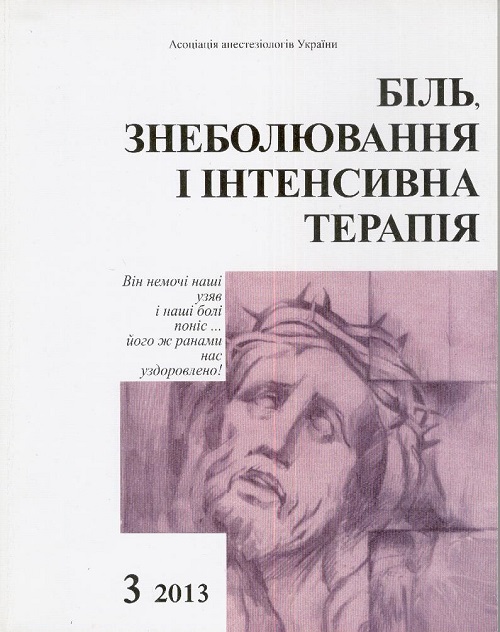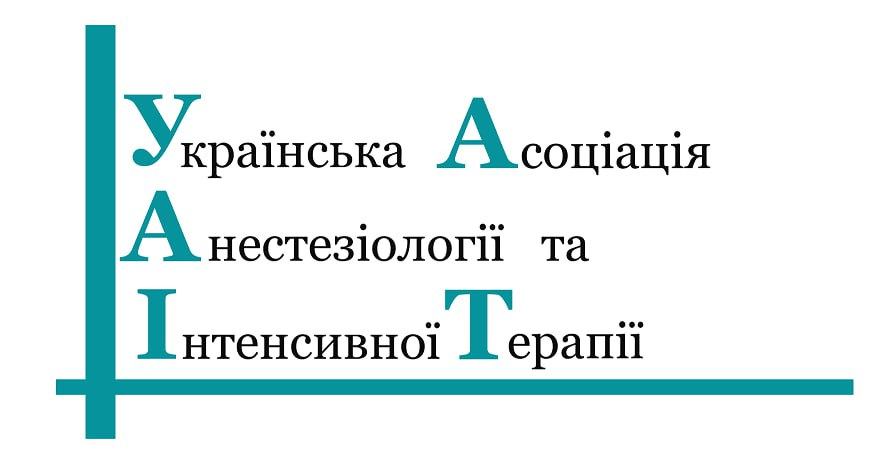Можливості використання трансторакальної ехокардіографії для прогнозування рівня волемії
DOI:
https://doi.org/10.25284/2519-2078.3(64).2013.105859Ключові слова:
волемічне навантаження, трансторакальна ехокардіографія, варіабельність діаметра нижньої порожнистої вениАнотація
Недостатній рівень внутрішньосудинного наповнення призводить до незадовільної перфузії тканин з наступним ацидозом і дисфункції органів. Надмірне парентеральне введення рідини спричиняє гостре пошкодження легенів, подовжуючи як тривалість штучної вентиляції легень, так і термін перебування у відділенні інтенсивної терапії. Використання трансторакальної ехокардіографії для визначення варіабельності діаметра нижньої порожнистої вени шляхом піднімання нижніх кінцівок забезпечує високий ступінь відтворюваності методу для оцінки відповіді на волемічне навантаження. Методика може бути використана як ізольований метод і у поєднанні з іншими методиками для виключення можливих помилок.Посилання
Wiedemann Н.Р., Wheeler А.Р., Bernard G.R. (2006) Comparison of two fluid-management strategies in acute lung injury. The New England Journal of Medicine;354:2564-2575. https://doi.org/10.1056/nejmoa062200
Kircher B.J., Himelman R.B., Schiller N.B. (1990) Noninvasive estimation of right atrial pressure from the inspiratory collapse of the inferior vena cava. American Journal of Cardiology;66:493- 496. https://doi.org/10.1016/0002-9149(90)90711-9
Bigatello L.M., Kistler E.B., Noto A. (2010) Limitations o f volumetric indices obtained by transthoracic thermodilution. Minerva Anestesiologica; 76:945-949.
Harvey S., Harrison D.A., Singer D (2005) Assessment of the clinical effectiveness of pulmonary artery catheters in management of patients in intensive care (PAC-Man): a randomised controlled trial. The Lancet;366: 472-477. https://doi.org/10.1016/s0140-6736(05)67061-4
Michard F. (2011) Stroke volume variation: From applied physiology to improved outcomes. Critical Care Medicme;39:402-403. https://doi.org/10.1097/ccm.0b013e318205c0a6
Reuter D.A., Felbinger T.W., Schmidt C. (2002) Stroke volume variations for assessment of cardiac responsiveness to volume loading in mechanically ventilated patients after cardiac surgery. Intensive Care Medicine;28:392-398. https://doi.org/10.1007/s00134-002-1211-z
Rutlen D.L., Wackers F.J., Zaret B.L. (1981) Radionuclide assessment of peripheral intravascular capacity: a technique to measure intravascular volume changes in the capacitance circulation in man. Circulation;64:146-152. https://doi.org/10.1161/01.cir.64.1.146
Lafanechère А., Pène F., Goulenok C. (2006) Changes in aortic blood flow induced by passive leg raising predict fluid responsiveness in critically ill patients. Critical Care; 10:R132. https://doi.org/10.1186/cc5044
Pronovost P., Needham D., Berenholtz S. (2006) An Intervention to Decrease Catheter-Related Bloodstream Infections in the ICU. New England Journal of Medicine; 355:2725-2732. https://doi.org/10.1056/nejmoa061115
Bossuyt P.M., Reitsma J.B., Bruns D.E. (2003) Towards complete and accurate reporting of studies of diagnostic accuracy: the STARD initiative. British Medical Journal; 326:4l-44. https://doi.org/10.1136/bmj.326.7379.41
Gatsonis C, Paliwal P. (2006) Meta-analysis of diagnostic and screening test accuracy evaluations: methodologic primer. American Journal of Roentgenology; 187: 271-281. https://doi.org/10.2214/ajr.06.0226
Préau S., Saulnier F, Dewavrin F., Chagnon JL (2010) Passive leg raising is predictive of fluid responsiveness in spontaneously breathing patients with severe sepsis or acute pancreatitis. Critical Care Medicine; 38:819-825. https://doi.org/10.1097/ccm.0b013e3181c8fe7a
Maizel J., Airapetian N., Lome E. et al. (2007) Diagnosis of central hypovolemia by using passive leg raising. Intensive Care Medicine; 33:1133-1138. https://doi.org/10.1007/s00134-007-0642-y
Lamia B., Ochagavia A., Monnet X. et al. (2007) Echocardiographic prediction of volume responsiveness in critically ill patients with spontaneously breathing activity Intensive Care Medicine;33:1125-1132. https://doi.org/10.1007/s00134-007-0646-7
Biais М., Vidil L., Sarrabay Р. et al. (2009) Changes in stroke volume induced by passive leg raising in spontaneously breathing patients: comparison between echocardiography and Vigileo™/FloTrac™ device. Critical Care; 13:R195. https://doi.org/10.1186/cc8195
Thiel S.W., Kollef M.H., Isakow W. (2009) Non-invasive stroke volume measurement and passive leg raising predict volume responsiveness in medical ICU patients: an observational cohort study. Critical Care;13: R111. https://doi.org/10.1186/cc7955
Barbier C., Loubières Y., Schmit C. (2004) Respiratory changes in inferior vena cava diameter are helpful in predicting fluid responsiveness in ventilated septic patients. Intensive Care Medicine; З0: 1740-1746. https://doi.org/10.1007/s00134-004-2259-8
Feissel M., Michard F., Faller J., Teboul J. (2009) The respiratory variation in inferior vena cava diameter as a guide to fluid therapy. Intensive Care Medicine;30:1834-1837. https://doi.org/10.1007/s00134-004-2233-5
Biais M., Nouette-Gaulain K., Roullet S. et al. (2009) A Comparison of Stroke Volume Variation Measured by Vigileo™/FloTrac™ System and Aortic Doppler Echocardiography. Anesthesia and Analgesia; 109:466-469. https://doi.org/10.1213/ane.0b013e3181ac6dac
Jensen M.B., Sloth E., Larsen K., Schmidt M. (2004) Transthoracic echocardiography for cardiopulmonary monitoring in intensive care. European Journal o f Anaesthesiology ;21:700-707. https://doi.org/10.1097/00003643-200409000-00006
Rivers E., Nguyen B., Havstad S. (2001) Early goal-directed therapy in the treatment of severe sepsis and septic shock The New England Journal of Medicine:345:1368-1377. https://doi.org/10.1056/nejmoa010307
Brandstrup B., Tønnesen H., Beier-Holgersen R. (2003) Effects of intravenous fluid restriction on postoperative complications: comparison of two perioperative fluid regimens. Annals of Surgery;238:641-648. https://doi.org/10.1097/01.sla.0000094387.50865.23
Vignon P., Allot V., Lesage J. (2007) Diagnosis of left ventricular diastolic dysfunction in the setting of acute changes in loading conditions. Critical Care: 11:3-12. https://doi.org/10.1186/cc5736
Nagueh S., Middleton K.. Kopelen H. et al. (1997) Doppler tissue imaging: a noninvasive technique for evaluation of left ventricular relaxation and estimation of filling pressures. American College of Cardiology;30:1527-1533. https://doi.org/10.1016/s0735-1097(97)00344-6
Royse C., Royse A., Soeding P., Blake D. (2001) Shape and movement of the interatrial septum predicts change. Critical Care Research and Practice;7:79-83.
Lichtenstein D., Mezière A., Lagoueyte J. et al. (2009) A-Lines and B-Lines: Lung ultrasound as a bedside tool for predicting pulmonary artery occlusion pressure in the critically ill. Chest; 136:1014-1020. https://doi.org/10.1378/chest.09-0001
Teboul J.L., Monnet X., Richard C. (2010) Weaning failure of cardiac origin: recent advances. Critical Care;14:211. https://doi.org/10.1186/cc8852
Walker D. (2010) Echocardiography: time for an in-house national solution to an unmet clinical need? Intensive Care Society;11:147. https://doi.org/10.1177/175114371001100220
Charron C., Fessenmeyer C., Cosson C. (2006) The influence of tidal volume on the dynamic variables of fluid responsiveness in critically ill patients. Anesthesia and Analgesia; 102:1511-1517. https://doi.org/10.1213/01.ane.0000209015.21418.f4
Mulvagh S.L., Rakowski H., Vannan M.A. (2008) American Society of Echocardiography consensus statement on the clinical applications of ultrasonic contrast agents in echocardiography. American Society o f Echocardiography; 21:1179-1201. https://doi.org/10.1016/j.echo.2008.09.009
Wei J., Yang H.S., Tsai S.K. (2011) Emergent bedside real-time three-dimensional transesophageal echocardiography in a patient with cardiac arrest following a caesarean section. European Journal of Echocardiography; 12:1-6. https://doi.org/10.1093/ejechocard/jeq161
Jacobs L.D., Salgo I.S., Goonewardena S. (2006) Rapid online quantification of left ventricular volume from real-time three-dimensional echocardiographic data. European Heart Journal;27: 460-468. https://doi.org/10.1093/eurheartj/ehi666
##submission.downloads##
Опубліковано
Як цитувати
Номер
Розділ
Ліцензія
Авторське право (c) 2013 О. А. Павлов, Ю. В. Богун, Б. А. Кабаков

Ця робота ліцензується відповідно до Creative Commons Attribution-NonCommercial 4.0 International License.
Автори, які публікуються у цьому журналі, погоджуються з наступними умовами:
a. Автори залишають за собою право на авторство своєї роботи та передають журналу право першої публікації цієї роботи на умовах ліцензії Creative Commons Attribution-NonCommercial 4.0 International License, котра дозволяє іншим особам вільно розповсюджувати опубліковану роботу з обов'язковим посиланням на авторів оригінальної роботи та першу публікацію роботи у цьому журналі.
b. Автори мають право укладати самостійні додаткові угоди щодо неексклюзивного розповсюдження роботи у тому вигляді, в якому вона була опублікована цим журналом (наприклад, розміщувати роботу в електронному сховищі установи або публікувати у складі монографії), за умови збереження посилання на першу публікацію роботи у цьому журналі.
c. Політика журналу дозволяє і заохочує розміщення авторами в мережі Інтернет (наприклад, у сховищах установ або на особистих веб-сайтах) рукопису роботи, як до подання цього рукопису до редакції, так і під час його редакційного опрацювання, оскільки це сприяє виникненню продуктивної наукової дискусії та позитивно позначається на оперативності та динаміці цитування опублікованої роботи (див. The Effect of Open Access).








